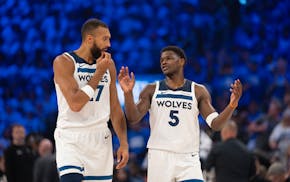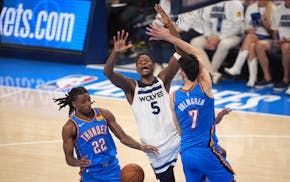For the first time this season, the Vikings are experimenting with a new-age offensive strategy called the forward rush.
In their first three games, the Vikings were led in yards per carry by backup quarterback Shaun Hill, at 4.0. That he was able to make it that far while using a walker is remarkable.
Adrian Peterson averaged 1.6 yards per carry, or less than he would have averaged had he simply fallen forward from the line of scrimmage on every play.
Matt Asiata averaged 2.6 per carry. The Vikings as a team averaged 2.1. And Jerick McKinnon, the fastest and most elusive of the Vikings' backs, averaged 2.8 yards.
While the Vikings rely on their defense, winning big without a hint of a running game would seem to be unsustainable. On Monday night, McKinnon demonstrated that he can make a difference on offense while making the offense different.
Poor line play created most of the Vikings' problems running the ball, but Peterson wasn't helping before he got hurt. He was too willing to take losses, and offensive coordinator Norv Turner felt compelled to build his game plans around his most talented player.
McKinnon can't wear down a defense over four quarters the way Peterson did, and that knowledge alleviates the temptation to try.
McKinnon would rather make defenses miss than hurt. He did his damage finding open field on Monday, rushing 18 times for 85 yards and a touchdown, and catching three passes for 10 yards in the Vikings' 24-10 victory over the Giants.
He ran once after taking a direct snap, and his 25-yard run gave him the team's two longest runs of the season.
At Carolina in Week 3, the offense sputtered in the first half. In the second half, Turner went to a short passing game to keep pressure from reaching quarterback Sam Bradford, and to take advantage of the strength of the Vikings' skill-position players — running after the catch.
In that offense, McKinnon can be a better fit than Peterson.
He's a far better receiver. And if you were judging only this season, you'd have to come to the conclusion that McKinnon's lateral quickness gives him a better chance than Peterson to succeed when the offensive line doesn't create a hole.
"AP told me to play hide-and-go-seek,'' McKinnon said. "And go take it.''
Where Peterson's absence hurts the most is in game-planning and deep passing. When Tony Dungy was the Vikings' defensive coordinator in the '90s, he liked to say that the advantage of having a star on either side of the ball was that the star's presence dictated the opponent's strategy. Without Peterson, the Vikings are less predictable, but so are defenses.
The Vikings' longest offensive play of this season — Bradford's 46-yard pass to Stefon Diggs against the Packers — was the result of lining up in a power-running formation with Peterson, drawing a safety toward the line of scrimmage and creating a one-on-one matchup deep downfield.
Deep passing might not be vital for this team. When your defense is dominant, low-risk offense makes sense, and the Vikings have yet to throw an interception or have an offensive player lose a fumble.
With a lack of dynamic wideouts after Diggs, the Vikings are finding tight end Kyle Rudolph to be their second-best receiver. McKinnon could become their third.
"He can run, he can catch, he can block,'' right tackle Andre Smith said. "He can run inside or outside.''
And take a direct snap. "That, too,'' Smith said.
In 2010, Rick Spielman used a second-round draft pick on Stanford tailback Toby Gerhart. That always felt like a strange move, given Peterson's dominance, and Gerhart rarely played a significant role on a team with bigger needs than backup running back.
In 2014, Spielman used a third-round pick on McKinnon. This made more sense. Peterson was 4 years older, had undergone a major knee surgery, and McKinnon could be used as a role player as well as backup.
Today McKinnon is the best healthy back on a very good team, and that may not change for quite a while.
Jim Souhan's podcast can be heard at MalePatternPodcasts.com. On Twitter: @SouhanStrib. • jsouhan@startribune.com

Souhan: Anxiety and depression in the NFL helped inspire Lindsey Young's children's book
Souhan: For Lynx star Napheesa Collier, 'Phee' is just fine

Souhan: Will the Wolves trade for Kevin Durant? Should they?

Souhan: If Edwards is a franchise player, he needs to act and play like it


